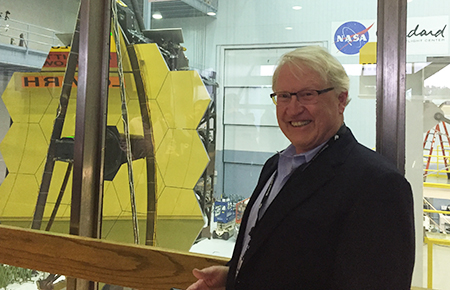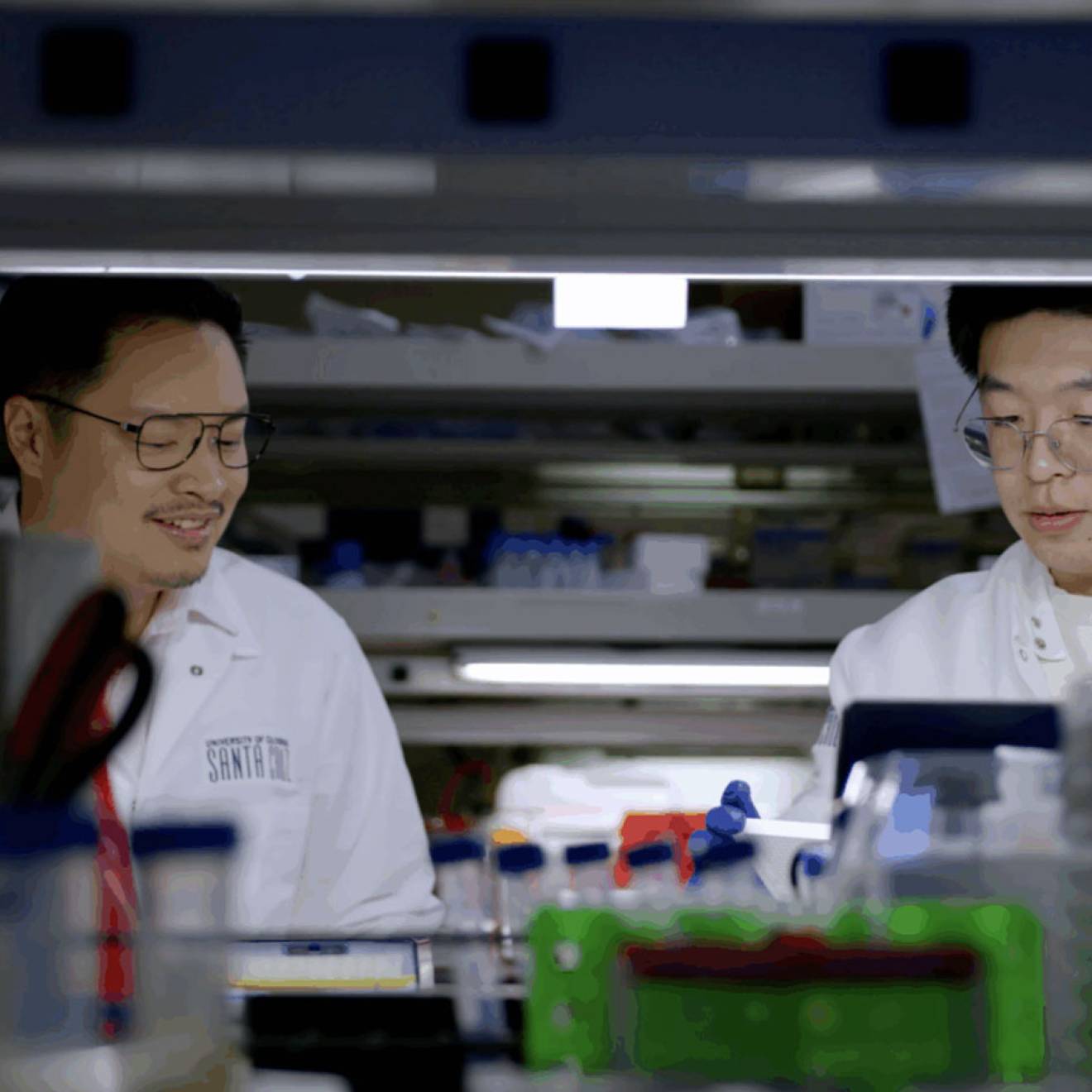UC Santa Cruz

NASA’s James Webb Space Telescope (JWST), scheduled to launch December 24 from the European Spaceport in French Guiana, is the largest, most powerful and complex telescope ever launched into space. The $10 billion infrared telescope will complement and extend the discoveries of the Hubble Space Telescope, providing greater sensitivity with its much larger primary mirror and capturing longer wavelengths of light.
“JWST is so much more powerful than our best current telescopes — 100 times Hubble — it’s going to impact every area of astronomy, just like Hubble did,” said Garth Illingworth, a distinguished professor emeritus of astronomy and astrophysics at UC Santa Cruz. “And when you look at the UC Santa Cruz astronomy group, there’s no doubt we are well positioned to play a major role in this mission, as we’ve done with Hubble.”
Illingworth himself has been a key player in JWST’s long journey from concept to completion — leading initial planning studies, chairing important advisory committees such as the JWST Science Advisory Committee (JSTAC), which he chaired for 8 years, and most recently serving as an external advisor on JWST to the director of NASA Goddard Space Flight Center. JSTAC played a key role in maximizing the science return from JWST by, for example, defining the Early Release Science program, which gives astronomers quick access to fully open, public data, as well as advising NASA on the resources needed to fund JWST’s science programs.
Seeing the telescope as it underwent final tests before being shipped to the launch site, Illingworth couldn’t help but think back to his work more than three decades ago on what was then called the Next Generation Space Telescope (NGST). At the time, he was deputy director of the Space Telescope Science Institute (STScI), and Hubble had not even been launched yet.
“It’s a little unbelievable to see it finished,” he said. “Although the details of the implementation are very different, the core features of the concept we came up with in 1987 is basically what we’re flying.”
JWST will probe the earliest, most distant galaxies in the universe, peer into stellar nurseries shrouded in dust, and observe faint planets orbiting nearby stars, opening new windows for exploring every phase of cosmic history.
The telescope’s 21-foot (6.5-meter) primary mirror enables it to gather more light from faint objects than Hubble’s 8-foot (2.4-meter) mirror, and its infrared vision, capturing wavelengths longer than visible light but shorter than radio waves, gives it unprecedented powers. Ultraviolet and visible light emitted by the first stars more than 13 billion years ago has been stretched by the expansion of the universe and is reaching us today as infrared light. Infrared light also penetrates the clouds of gas and dust in which stars and planets form.
Other worlds
UC Santa Cruz astronomers will be involved in projects within each of the four main science themes JWST will study (first stars and galaxies, galaxies over time, lifecycle of stars, and planetary systems). A large group of UC Santa Cruz astronomers is studying planets around other stars (exoplanets), one of the most exciting areas in which JWST is expected to open new territory.
“It’s going to be transformational,” said Jonathan Fortney, professor of astronomy and astrophysics and director of the Other Worlds Laboratory at UC Santa Cruz. “JWST will revolutionize the field in terms of telling us about the atmospheres of exoplanets in a way we haven’t been able to do before. Hubble is great, but it was never designed to get spectra of exoplanets.”
A spectrum shows the wavelengths of light from an object and can be used to identify the molecules present in a planet’s atmosphere. Infrared spectra from JWST’s instruments will reveal the chemical fingerprints of exoplanet atmospheres. “Infrared is good for seeing things like water, methane, ammonia — really common molecules in our solar system that we will now be able to see in other planetary systems,” Fortney said.
UC Santa Cruz astronomers will be leading the first observations of exoplanets with JWST through the Early Release Science (ERS) program.
Exoplanet hub
“We’re on the threshold of a new decade of exoplanet observations that will be characterized by the study of their atmospheres, and UC Santa Cruz is a hub for atmospheric exoplanet science,” said Natalie Batalha, professor of astronomy and astrophysics and principal investigator of an ERS program to study transiting exoplanets.
A transiting exoplanet is one that passes in front of its host star, allowing astronomers to analyze light filtered through the planet’s atmosphere. Direct imaging of exoplanets is the focus of another ERS program co-led by associate professor Andrew Skemer.
Skemer explained that the ERS programs are intended to give the astronomy community a quick assessment of the performance of the telescope’s instruments in each of their specific observation modes.
“The exoplanet observations are unusual compared to other JWST observations. For transits you need very precise time series, and for direct imaging you have to subtract the glare of the star so you can see the faint planet,” he said. “There’s never been a telescope like JWST before, so figuring out how to do this optimally is very important, and we want to get these important datasets into the hands of the community as soon as possible. In the process, we’ll be doing some interesting science.”
In addition to the ERS programs, UC Santa Cruz astronomers will be involved in a broad range of projects in JWST’s Cycle 1 programs, including several major exoplanet studies. Batalha said she is particularly excited to learn more about the abundant “super-Earths” found by NASA’s Kepler Mission, for which she was project scientist.
“Kepler taught us that the diversity of exoplanets far exceeds the diversity in our own solar system,” she said. “The most common type of exoplanets are these super-Earths or sub-Neptunes that are intermediate in size between terrestrial planets and giant planets. We need to understand what those planets are like, because that has significant implications for understanding the propensity for life in the galaxy.”
Batalha, who leads a NASA Interdisciplinary Consortium for Astrobiology Research, will also be collaborating with Natasha Batalha at NASA Ames Research Center, the principal investigator of the largest exoplanet program in Cycle 1 (and Natalie’s daughter). Fortney, Skemer, and Aarynn Carter, a postdoctoral scholar working with both Batalha and Skemer, will be leading several other exoplanet projects, including a search for newly formed planets lurking in the disks of protoplanetary material observed around some stars.
“We’re going to be James Webb exoplanet central here,” Skemer said. “And that’s just the exoplanet research.”
First galaxies
UC Santa Cruz astronomers are also key players in investigations of the earliest galaxies. Professor of astronomy and astrophysics Brant Robertson is involved in several major programs using JWST to map the distribution of galaxies in the early universe and study how the first galaxies formed and evolved over time. With its infrared vision and large mirror, JWST will be a powerful time machine, peering deeper into the universe and further back in time than ever before possible.
Robertson serves on the steering committee for the largest single program in Cycle 1, the JWST Advanced Deep Extragalactic Survey (JADES), a collaboration between two instrument teams that will use about 800 hours of observing time. As part of the Guaranteed Time Observations program, the JADES collaboration will retain the data for an initial exclusive access period.
“JADES is designed so we can take deep images to find the most distant galaxies, and then follow up by taking spectra of those galaxies, which will allow us to pinpoint their ages and measure all kinds of amazing properties, such as how fast they are making stars and how rich in metals they are,” he said. “We will be able to look at the first population of galaxies in the universe and say what they are and how they came to be.”
Robertson is also the lead theorist for the COSMOS-Webb galaxy survey, the largest of the Cycle 1 General Observer Programs, with more than 200 hours of observing time, and is a co-investigator of PRIMER, a major public Treasury Program. Each of these complementary galaxy surveys will make important contributions to understanding the story of how galaxies formed in the early universe. COSMOS covers the widest area but not as deeply as the other surveys, PRIMER is the next biggest in area and goes slightly deeper, and JADES goes even deeper and adds spectroscopy to tease out the properties of the galaxies.
“They’re like the tiers of a wedding cake, and we’ll be learning different things about the galaxy population with each one,” Robertson said.
Illingworth is involved in “first galaxies” projects, too, including serving as the U.S. lead for PRIMER and another international Treasury Program (FRESCO), both of which, like the ERS programs, will provide unrestricted data access. Illingworth’s team pushed Hubble and the Spitzer Space Telescope to their limits to capture the most distant galaxies ever observed. Now JWST is poised to go much further and transform our understanding of the earliest galaxies. Illingworth said he expects JWST to yield new discoveries even in its first few days of observations.
“It’s so astonishingly powerful, it will answer a lot of questions about how the first galaxies are growing in the first 1 to 2 percent of the life of the universe,” he said. “First galaxies were at the heart of what JWST was conceived to do over 20 years ago. Tackling this incredibly challenging problem is going to be so exciting.”
Neutron stars
Other UC Santa Cruz faculty leading JWST observations include astrophysicist Ryan Foley, whose team will be using the space telescope for follow-up observations of gravitational wave sources, capturing infrared light from the “kilonova” explosion when two neutron stars collide. “It’s really an exciting program,” he said. “We need JWST’s unique capability to go deeper into the infrared and capture a real picture of what’s going on in these events.”
Like many projects of this size and complexity, JWST was plagued by delays and cost overruns. Illingworth has been in the thick of it in his various roles, responding to funding crises and advising Congress and NASA administrators to help keep the project moving forward. Under-budgeting was at the root of many issues, he said. “Every project needs to carry large enough reserves so you have money available to fix problems immediately when they arise, because the costs go up so fast whenever there are delays,” he said.
Now that the telescope is finally ready for launch, the anticipation is mounting for astronomers at UC Santa Cruz and throughout the world.
“In certain fields, JWST is going to blow everything else away,” Skemer said. “Some types of observations we will never do from the ground again.”
JWST is an international collaboration between NASA, the European Space Agency, and the Canadian Space Agency. The Space Telescope Science Institute will operate the telescope after launch. It will take about a month to get the telescope and its sunshield deployed and settled into its orbit 1 million miles from Earth, and another 5 months to get JWST fully commissioned and operational before it can begin observations.

UC Santa Cruz astronomer Garth Illingworth outside the large clean room at NASA Goddard Space Flight Center, with the gold mirror of the James Webb Space Telescope in the background.

